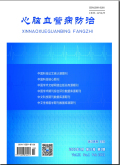心脑血管病防治2024,Vol.24Issue(5):19-22,4.DOI:10.3969/j.issn.1009-816x.2024.05.005
活性氧响应靶向纳米粒对细胞氧化应激和细胞炎症因子的影响
Effects of reactive oxygen species-responsive targeted nanoparticles on cellular oxidative stress and inflammatory cytokines
摘要
Abstract
Objective To investigate the effects of reactive oxygen species(ROS)-responsive targeted nanoparticles(OXbCD NP)on cellular oxidative stress and inflammatory cytokines.Methods ROS-responsive targeted nanoparticles were synthesized using chemical bonding.(1)RAW264.7 cells were randomly divided into 4 groups:blank 1 group(no treatment),control 1 group(PMA stimulation),10 μg/mL OXbCD NP 1 group(10 μg/mL OXbCD NP incubation followed by PMA stimulation),100 μg/mL OXbCD NP 1 group(100 μg/mL OXbCD NP incubation followed by PMA stimulation).The intracellular levels of ROS were detected by DCFH-DA staining and flow cytometry,and fluorescence imaging was performed.(2)RAW264.7 cells were randomly divided into 4 groups:blank 2 group(no treatment),control 2 group(IFN-γ and LPS stimulation),10 μg/mL OXbCD NP 2 group(10 μg/mL OXbCD NP incubation followed by IFN-γ and LPS stimulation),and 100 μg/mL OXbCD NP 2 group(100 μg/mL OXbCD NP incubation followed by IFN-γ and LPS stimulation).ELISA was used to detect interleukin-1β(IL-1β)and tumor necrosis factor-α(TNF-α)levels.(3)RAW264.7 cells were incubated in OXbCD NP solution at concentrations of 0 μg/mL,5 μg/mL,10 μg/mL,20 μg/mL,40 μg/mL,80 μg/mL,160 μg/mL,320 μg/mL,640 μg/mL and 1 280 μg/mL for 12 h or 24 h,and cell viability was detected by MTT assay.Results(1)Compared to the control 1 group,ROS levels and fluorescence intensity in the 10 μg/mL and 100 μg/mL OXbCD NP 1 groups decreased,the difference were statistically significant(P<0.01);(2)Compared to the control 2 group,the levels of IL-1β and TNF-α in the 10 μg/mL and 100 μg/mL OXbCD NP 2 groups decreased,the difference were statistically significant(P<0.01).(3)The nanoparticles were incubated with the cells for 12 h,compared to OXbCD NP concentration of 0 μg/mL(without OXbCD NP),there were statistically significant differences in survival rates when OXbCD NP level reached 640 μg/mL and 1 280 μg/mL(P<0.05).When the incubation time was 24 h,compared to without OXbCD NP,significant differences in cell viability were observed when OXbCD NP concentration was 320 μg/mL,640 μg/mL,and 1 280 μg/mL(P<0.05).Conclusion ROS-responsive targeted nanoparticles demonstrate good safety at the cellular level and possess anti-cellular oxidative stress and anti-inflammatory cytokines effects.关键词
纳米粒/活性氧/细胞氧化应激Key words
Nanoparticles/Reactive oxygen species/Cell oxidative stress引用本文复制引用
曹隆檬,金虎..活性氧响应靶向纳米粒对细胞氧化应激和细胞炎症因子的影响[J].心脑血管病防治,2024,24(5):19-22,4.基金项目
温州市科技局课题(Y20210895) (Y20210895)

